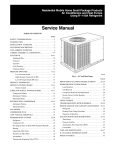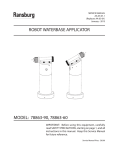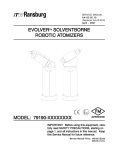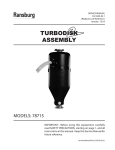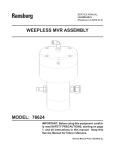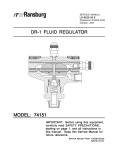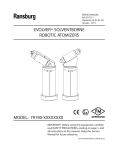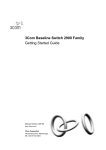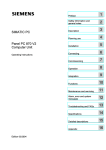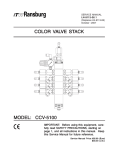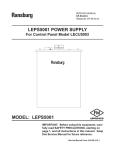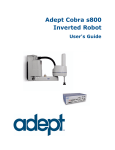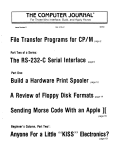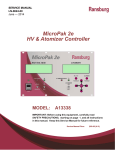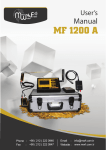Download AA-99-01.1 EFM & EMFD.pmd
Transcript
SERVICE MANUAL AA-99-01.1 (Replaces AA-99-01) June - 2007 EFMTM AND EFMDTM SOL VENTBORNE ROBOTIC A TOMIZERS SOLVENTBORNE AT MODEL: 76480, 76482, 76485, 76488 IMPOR TANT IMPORT ANT:: Before using this equipment, carefully read SAFETY PRECAUTIONS, starting on page 1, and all instructions in this manual. Keep this Service Manual for future reference. Service Manual Price: €40.00 40.00 (Euro) $50.00 (U.S.) NOTE: This manual has been changed from revision AA-99-01 to revision AA-99-01.1 AA-99-01.1. Reasons for this change are noted under “Manual Change Summary” inside the back cover of this manual. AA-99-01.1 EFM(D) Solventborne Robotic Atomizers - Contents CONTENTS PAGE SAFETY: 1-4 SAFETY PRECAUTIONS............................................................................................................ 1 HAZARDS / SAFEGUARDS....................................................................................................... 2-4 INTRODUCTION: 5-8 THE ITW RANSBURG ELECTROSTATIC PROCESS............................................................. 5 EFM AND EFMD SOLVENTBORNE GUNS.............................................................................. 5-6 SPECIFICATIONS....................................................................................................................... 6 MANIFOLD SELECTION GUIDE................................................................................................ 7 APPLICATOR TOOL-POINT REPRESENTATION................................................................... 8 INSTALLATION: 9-14 EFM AND EFMD ROBOTIC ATOMIZER INSTALLATION........................................................ 9 POWER SUPPLY ASSEMBLY................................................................................................... 9 LOW VOLTAGE CABLE CONNECTIONS................................................................................. 10 ROBOT MANIFOLD ASSEMBLY................................................................................................ 11 EFM SPRAY GUN....................................................................................................................... 11 ROBOT MANIFOLD AND SPRAY GUN INSTALLATION / PARTS LIST................................................................................................................................. 13-14 OPERATION: 15-18 SPRAY APPLICATOR CONTROLS........................................................................................... 15 POWER SUPPLY CONTROLS.................................................................................................. 15 GENERAL INFORMATION AND ADJUSTMENTS................................................................... 15-17 SIMPLIFIED AIR AND FLUID FLOW PASSAGE LAYOUT....................................................... 17 INTRINSIC SAFE WIRING.......................................................................................................... 18 MAINTENANCE: 19-34 ROUTINE MAINTENANCE SCHEDULE.................................................................................... 19-20 PROCEDURES............................................................................................................................ 20-21 SERVICE...................................................................................................................................... 21 SPRAY HEAD ASSEMBLY / PARTS LIST................................................................................. 22-24 FLUID REGULATOR OR DUMP VALVE / PARTS LIST........................................................... 25-26 REMOVING GUN FROM THE ROBOT MANIFOLD ASSEMBLY / PARTS LIST.......................................................................................................... 27 AIR CARTRIDGE VALVES......................................................................................................... 28-29 SOLENOID TRIGGER VALVES / PARTS LIST......................................................................... 29-30 LECU5004 MICROPAK CONTROL UNIT.................................................................................. 31 76494-XXX ROBOT MANIFOLD ASSEMBLY............................................................................ 31 ACCESSORIES........................................................................................................................... 31-34 (Continued On Next Page) AA-99-01.1 EFM(D) Solventborne Robotic Atomizers - Contents PARTS IDENTIFICATION: PAGE 35-70 76479 SPRAY HEAD ASSEMBLY / PARTS LIST....................................................................... 35-36 76490 APPLICATOR MANIFOLD PLATE ASSEMBLY / PARTS LIST...................................... 37-38 76494 MANIFOLD ASSEMBLY / PARTS LIST............................................................................ 39-42 76480 EFM APPLICATOR ASSEMBLY / PARTS LIST.............................................................. 43-44 76366 VALVE MANIFOLD ASSEMBLY / PARTS LIST............................................................... 45-46 76481 APPLICATOR HOUSING ASSEMBLY / PARTS LIST.................................................... 47-48 76482 EFM APPLICATOR ASSEMBLY / PARTS LIST.............................................................. 49-50 76484 VALVE MANIFOLD ASSEMBLY / PARTS LIST............................................................... 51-52 76483 APPLICATOR HOUSING ASSEMBLY / PARTS LIST.................................................... 53-54 76485 EFMD APPLICATOR ASSEMBLY / PARTS LIST............................................................ 55-56 76487 VALVE MANIFOLD ASSEMBLY / PARTS LIST............................................................... 57-59 76486 APPLICATOR HOUSING ASSEMBLY / PARTS LIST.................................................... 61-62 76488 EFMD APPLICATOR ASSEMBLY / PARTS LIST............................................................ 63-64 76368 VALVE MANIFOLD ASSEMBLY / PARTS LIST............................................................... 65-67 76489 APPLICATOR HOUSING ASSEMBLY / PARTS LIST.................................................... 69-70 WARRANTY POLICIES: 71 LIMITED WARRANTY.................................................................................................................. 71 AA-99-01.1 AA-99-01.1 EFM(D) Solventborne Robotic Atomizers - Safety SAFETY SAFETY PRECAUTIONS Before operating, maintaining or servicing any ITW Ransburg electrostatic coating system, read and understand all of the technical and safety literature for your ITW Ransburg products. This manual contains information that is important for you to know and understand. This information relates to USER SAFETY and PREVENTING EQUIPMENT PROBLEMS. To help you recognize this information, we use the following symbols. Please pay particular attention to these sections. A WARNING! states information to alert you to a situation that might cause serious injury if instructions are not followed. A CAUTION! states information that tells how to prevent damage to equipment or how to avoid a situation that might cause minor injury. A NOTE is information relevant to the procedure in progress. While this manual lists standard specifications and service procedures, some minor deviations may be found between this literature and your equipment. Differences in local codes and plant requirements, material delivery requirements, etc., make such variations inevitable. Compare this manual with your system installation drawings and appropriate ITW Ransburg equipment manuals to reconcile such differences. ! WARNING > The user MUST read and be familiar with the Safety Section in this manual and the ITW Ransburg safety literature therein identified. > This manual MUST be read and thoroughly understood by ALL personnel who operate, clean or maintain this equipment! Special care should be taken to ensure that the WARNINGS and safety requirements for operating and servicing the equipment are followed. The user should be aware of and adhere to ALL local building and fire codes and ordinances as well as NFPA33 SAFETY STANDARD, prior to installing, operating, and/or servicing this equipment. ! WARNING > The hazards shown on the following page may occur during the normal use of this equipment. Please read the hazard chart beginning on page 2. Careful study and continued use of this manual will provide a better understanding of the equipment and process, resulting in more efficient operation, longer trouble-free service and faster, easier troubleshooting. If you do not have the manuals and safety literature for your Ransburg system, contact your local ITW Ransburg representative or ITW Ransburg. 1 AA-99-01.1 EFM(D) Solventborne Robotic Atomizers - Safety AREA HAZARD SAFEGUARDS Tells where hazards Tells what the hazard is. Tells how to avoid the hazard. Fire Hazard Fire extinguishing equipment must be present in the spray area and tested periodically. may occur. Spray Area Improper or inadequate operation and maintenance procedures will Spray areas must be kept clean to prevent the cause a fire hazard. accumulation of combustible residues. Protection against inadvertent arcing that is capable of causing fire or explosion is lost if any safety interlocks are disabled during operation. Frequent power supply shutdown indicates a problem in the system requiring correction. Smoking must never be allowed in the spray area. The high voltage supplied to the atomizer must be turned off prior to cleaning, flushing or maintenance. When using solvents for cleaning: Those used for equipment flushing should have flash points equal to or higher than those of the coating material. Those used for general cleaning must have flash points above 100°F (37.8°C). Spray booth ventilation must be kept at the rates required by NFPA-33, OSHA, and local codes. In addition, ventilation must be maintained during cleaning operations using flammable or combustible solvents. Electrostatic arcing must be prevented. Test only in areas free of combustible material. Testing may require high voltage to be on, but only as instructed. Non-factory replacement parts or unauthorized equipment modifications may cause fire or injury. If used, the key switch bypass is intended for use only during setup operations. Production should never be done with safety interlocks disabled. Never use equipment intended for use in waterborne installations to spray solvent based materials. The paint process and equipment should be set up and operated in accordance with NFPA-33, NEC, and OSHA requirements. AA-99-01.1 2 EFM(D) Solventborne Robotic Atomizers - Safety AREA HAZARD SAFEGUARDS Tells where hazards Tells what the hazard is. Tells how to avoid the hazard. may occur. General Use and Maintenance Improper operation or maintenance Personnel must be given training in accordance with may create a hazard. the requirements of NFPA-33. Personnel must be properly trained Instructions and safety precautions must be read and in the use of this equipment. understood prior to using this equipment. Comply with appropriate local, state, and national codes governing ventilation, fire protection, operation maintenance, and housekeeping. Reference OSHA, NFPA-33, and your insurance company requirements. Electrical Equipment High voltage equipment is utilized. Arcing in areas of flammable or combustible materials may occur. Personnel are exposed to high voltage during operation and maintenance. The power supply, optional remote control cabinet, and all other electrical equipment must be located outside Class I or II, Division 1 and 2 hazardous areas. Refer to NFPA-33. Turn the power supply OFF before working on the equipment. Protection against inadvertent arcing that may cause a fire or Test only in areas free of flammable or combustible explosion is lost if safety circuits material. are disabled during operation. Testing may require high voltage to be on, but only as Frequent power supply shut-down instructed. indicates a problem in the system Production should never be done with the safety which requires correction. circuits disabled. An electrical arc can ignite coating materials and cause a fire or Before turning the high voltage on, make sure no objects are within the sparking distance. explosion. Explosion Hazard / Halogenated hydrocarbon solvents Aluminum is widely used in other spray application for example: methylene chloride equipment - such as material pumps, regulators, Incompatible and 1,1,1,-Trichloroethane are not triggering valves, etc. Halogenated hydrocarbon Materials chemically compatible with the aluminum that might be used in many system components. The chemical reaction caused by these solvents reacting with aluminum can become violent and lead to an equipment explosion. 3 solvents must never be used with aluminum equipment during spraying, flushing, or cleaning. Read the label or data sheet for the material you intend to spray. If in doubt as to whether or not a coating or cleaning material is compatible, contact your material supplier. Any other type of solvent may be used with aluminum equipment. AA-99-01.1 EFM(D) Solventborne Robotic Atomizers - Safety AREA HAZARD SAFEGUARDS Tells where hazards Tells what the hazard is. Tells how to avoid the hazard. may occur. Toxic Substances Certain material may be harmful if Follow the requirements of the Material Safety Data inhaled, or if there is contact with Sheet supplied by coating material manufacturer. the skin. Adequate exhaust must be provided to keep the air free of accumulations of toxic materials. Use a mask or respirator whenever there is a chance of inhaling sprayed materials. The mask must be compatible with the material being sprayed and its concentration. Equipment must be as prescribed by an industrial hygienist or safety expert, and be NIOSH approved. Spray Area / High Voltage Equipment There is a high voltage device that Parts being sprayed must be supported on conveyors can induce an electrical charge on or hangers and be grounded. The resistance between objects which is capable of igniting the part and ground must not exceed 1 megohm. coating materials. All electrically conductive objects in the spray area, Inadequate grounding will cause a with the exception of those objects required by the spark hazard. A spark can ignite process to be at high voltage, must be grounded. many coating materials and cause a fire or explosion. Any person working in the spray area must be grounded. Unless specifically approved for use in hazardous locations, the power supply and other electrical control equipment must not be used in Class 1, Division 1 or 2 locations. Robot Work Area - Improper use or maintenance can Applicator adjustments or maintenance should be lead to hazardous conditions, done after the robot is taken out of service. Do not General Use and particularly from unexpected robot adjust or repair the applicator if the robot is operating Maintenance manipulator movement. or standing ready to start. Refer to robot operating instructions for the procedures to take the robot out of service. Personnel Safety AA-99-01.1 Skin puncturing by sharp electrode. Take precautions to see that flesh is not punctured by sharp electrode. 4 EFM(D) Solventborne Robotic Atomizers - Introduction INTRODUCTION THE ITW RANSBURG ELECTROST ATIC ELECTROSTA PROCESS This process is a method for electrostatically applying coatings to objects. A power supply produces a high voltage charge which is supplied to the applicator, creating an electrostatic field between the applicator and the target object. The target is electrostatically grounded through its support which may be either stationary or moving. A regulated fluid system delivers coating material to the applicator, where it is atomized forming a spray mist. There, under the influence of the electrostatic field, the atomized coating becomes electrostatically charged. The charged particles are attracted to and deposited on the grounded target object. The forces between the charged particles and the target are sufficient to turn overspray around and deposit it on the back surface of the target. Therefore, a higher percentage of the spray is deposited. EFM AND EFMD SOL VENTBORNE SOLVENTBORNE APPLICA TORS APPLICAT The EFMTM Solventborne Applicator line consists of single and dual-headed 100 kV automatic electrostatic spray applicators. Developed for use on robots or reciprocators, the EFM solventborne applicator incorporates a quickdisconnect manifold and swivel tubing connections to minimize downtime. Internal fluid and air solenoids and an internal high voltage power supply provide the user a compact, efficient tool for the application of electrostatic coatings. Because this is a grounded fluid system, the EFM solventborne applicator is highly suitable for applying a wide range of solvent reduced coatings such as enamels, lacquers, two-component and other such coatings. 5 There are two single-head models of the EFM Applicator. Each model differs in the applicator to axis orientation of the spray head, these models are: 76480-02 EFM 60° Applicator 76482-02 EFM 90° Applicator Two dual-head versions of the EFM Solventborne Applicator are also available, designated EFMDTM. The dual-head version is identical to the EFM applicator with the exception of an additional spray head mounted to the applicator body. EFMD Solventborne Applicators are primarily used where high volume fluid delivery is required. These applicators supply twice the fluid delivery over Single-Head EFM Solventborne Applicators. The EFMD Solventborne Applicator is available in two different configurations as follows: 76485-02 EFMD 60° Applicator 76488-02 EFMD 90° Applicator Both EFM and EFMD Solventborne Applicators are comprised of five major sections: 1. Spray head(s) 2. Valve manifold assembly 3. Quick-disconnect base manifold assembly 4. Robot-mounted manifold assembly 5. High voltage cascade. The spray head(s) and valve manifold contain the fluid, air, and high voltage passages. Although the quick-disconnect base manifold and robotmounted manifold are fabricated from aluminum, all fluid passages are contained within stainless steel and nylon fittings and are compatible with halogenated hydrocarbon solvents. The robot manifold incorporates stainless steel swivel fluid connections. The swivel connections reduce stress on the fluid lines minimizing breakage. No aluminum parts are exposed to the fluid path on either manifold. The high voltage cascade is entirely encapsulated with a solvent resistant epoxy. AA-99-01.1 EFM(D) Solventborne Robotic Atomizers - Introduction The high voltage supply for the EFM and EFMD applicators consists of two major components: The MicroPakTM Power Supply Control Unit (LECU5004), and the HP404 Cascade (7593300). The MicroPak power supply control unit provides a low voltage signal through the robot manifold to the EFM or EFMD spray applicator. The high voltage cascade located within the applicator converts the low voltage DC signal to a high voltage electrostatic output. See MicroPak Control Unit Service Manual for details of the LECU5004, MicroPak control unit. Output Voltage: 30-100 kV Output Range: 0-125 μA Solenoid Parameters: 15.5 [email protected], 1/2W Paint Flow Rate: Variable to 1500 cc/min. Operating Air Pressures Atomizing Air: 100 psig max. Fan Air: 100 psig max. Trigger Air: 70 psig min./100 psig max. Regulator Pilot: 60 psig max. SPECIFICA TIONS SPECIFICATIONS Dump Pilot: Robot/Mounting Compatibility: ABB Robotics Fanuc P150/155/200 Motion Machine Gun Bar Applicator Control Unit: LECU5004 MicroPak control unit Weight Single-Headed: 76480-02 (60°) 8.25 lbs. 76482-02 (90°) 8.25 lbs. 60 psig max. Operating Fluid Pressure: 300 psig max. Robot Manifold Tubing Requirements Atomizing Air: 1/2" OD Nylon Fan Air: 1/2" OD Nylon Trigger Air: 3/16" OD Nylon Regulator Pilot: 3/16" OD Nylon Dump Pilot: 3/16" OD Nylon Dual-Headed: 76485-02 (60°) 9.50 lbs. 76488-02 (90°) 9.50 lbs. Manifold: 76494-XX 2.00lbs. (No tubing or Cable) Fluid: Polyethylene: 1/4" or 3/16" ID Teflon: 1/4" or 3/16" ID 76480-02 (60°) 15-5/8" 76482-02 (90°) 14-1/2" Dump: Polyethylene: 1/4" or 3/16" ID Teflon: 1/4" or 3/16" ID Length Single-Headed: Dual-Headed: 76485-02 (60°) 13-7/8" 76488-02 (90°) 13-3/8" * See "Manifold Selection Guide" in the "Introductin" section for proper manifold tubing size, material length order number. Manifold: 76494-16X 76494-25X 76494-50X AA-99-01.1 16' 25' 50' 6 EFM(D) Solventborne Robotic Atomizers - Introduction MANIFOLD SELECTION GUIDE WITH 3/16" ID POLYETHYLENE PAINT AND DUMP TUBING, ORDER: 76494-16A for 16' length tubing 76494-25A for 25' length tubing 76494-50A for 50' length tubing WITH 1/4" ID TEFLON PAINT AND DUMP TUBING, ORDER: 76494-16B for 16' length tubing 76494-25B for 25' length tubing 76494-50B for 50' length tubing WITH 3/16" ID TEFLON PAINT AND DUMP TUBING, ORDER: 76494-16C for 16' length tubing 76494-25C for 25' length tubing 76494-50C for 50' length tubing WITH 1/4" ID POLYETHYLENE PAINT AND DUMP TUBING, ORDER: 76494-16D for 16' length tubing 76494-25D for 25' length tubing 76494-50D for 50' length tubing WITH 3/16" ID TEFLON PAINT AND 1/4" ID TEFLON DUMP TUBING, ORDER: 76494-16E for 16' length tubing 76494-25E for 25' length tubing 76494-50E for 50' length tubing 7 AA-99-01.1 EFM(D) Solventborne Robotic Atomizers - Introduction To allow for ease of configuration, operation, and modification of robot teach patterns, the following spray point verticies are provided. Refer to Figure 1 for explanation of coordinates. X Y 76480-02 EFM-60 EFM-60° 14.812 13.397 76482-02 EFM-90 EFM-90° 12.894 14.313 76485-02 EFMD-60 EFMD-60° 13.252 14.738 76488-02 EFMD-90 EFMD-90° 11.240 15.078 Figure 1: AA-99-01.1 Applicator Tool-Point Representation 8 EFM(D) Solventborne Robotic Atomizers - Installation INST ALLA TION INSTALLA ALLATION EFM AND EFMD ROBOTIC A TOMIZER AT INST ALLA TION INSTALLA ALLATION NOTES This information is intended ONLY to indicate the general installation parameters of this product and, where applicable, its working relationship to other ITW Ransburg system components in typical use. Each installation is unique and should be directed by an authorized ITW Ransburg representative or conducted from the ITW Ransburg installation drawings provided for your particular installation. POWER SUPPL Y SUPPLY ASSEMBL Y ASSEMBLY Refer to the ITW Ransburg Service Manual MicroPak Control Unit, for complete information regarding power supply installation. Two low voltage control cables, 76495 and 76496, connect from the Output terminal connection (J3), located on the back of the power supply assembly. These cables connect from the terminal block (J3) to the robot manifold plate. ! WARNING > The power supply MUST be located outside the HAZARDOUS area (Reference OSHA and NFPA-33). > User should be aware of, and adhere to, all local fire codes and ordinances. > The user MUST provide a properly fused disconnect between the power source and the power supply which complies with appropriate codes. 9 AA-99-01.1 EFM(D) Solventborne Robotic Atomizers - Installation Figure 2: AA-99-01.1 Low Voltage Cable Connections 10 EFM(D) Solventborne Robotic Atomizers - Installation ROBOT MANIFOLD ASSEMBL Y ASSEMBLY (See Figure 3) Bundle the seven lengths of tubing along with the two low voltage power cables [6 & 7] and route them through the center of the robot face plate past the horizontal arm to the bulkhead bracket. Use the six 5mm x 20mm socket head cap screws [2] included with the robot manifold assembly to attach the manifold assembly to the face plate of the robot. Connect the tubes to the appropriate fittings on the bulkhead bracket. Connect low voltage power cables [6 & 7] of the robot manifold assembly to the MicroPak Controller. Shown is the version used with the P-150 series robots which connects to a terminal strip. If a terminal strip or connectors are used at the bulkhead plates, you must run the exact same cable from the terminal strip back to the MicroPak controller. Intrinsic safety rules must be followed when running these cables. See "Intrinisic Safe Wiring" in the "Operation" section of this manual. ! CAUTION EFM SPRA Y SPRAY APPLICA TOR APPLICAT (See Figure 3) Attach EFM spray applicator [1])to robot manifold plate [4] with six (6) 5/16-18 x 1 inch hex socket screws [5] included with each applicator. Nylon guide pins (A10004-00) and nylon hex socket screws (EMF-204-1) are offered as an option. These nylon parts may be used in place of the metal hex socket screws and metal guide pins. The plastic parts are designed to break quickly if aa applicator crash occurs. Possible applicator or robot damage may be avoided if the spray applicator breaks away from the robot wrist during contact with the workpiece. ! WARNING Install and route the hoses and cable so that they are NOT exposed to temperatures in excess of 120° F. Ensure that all hose and cable bends are NOT LESS THAN a 6 inch (15cm) radius and are not subjected to more than 360° of torsional twist. Failure to comply with these parameters could cause equipment malfunctions that might create HAZARDOUS CONDITIONS! > > Leave 12-24 inches of extra length on all lines to prevent extreme tension being applied to these lines during robot movement. 11 AA-99-01.1 EFM(D) Solventborne Robotic Atomizers - Installation NOTES AA-99-01.1 12 EFM(D) Solventborne Robotic Atomizers - Installation Figure 3: 13 Robot Manifold and Spray Applicator Installation AA-99-01.1 EFM(D) Solventborne Robotic Atomizers - Installation ROBOT MANIFOLD AND SPRA Y APPLICA TOR - P AR TS LIST SPRAY APPLICAT PAR ARTS (Figure 3) Item # 1 2 3 4 5 6 7 AA-99-01.1 Part # 76488-02 TR-SSF-024 76494-xx 76560-01 SSF-3125 76496-xx 76495-xx Description EFM Spray Applicator 5mm x 20mm Socket Head Cap Screws Robot Manifold Assembly Manifold Plate 5/16-18 x 1" Hex Socket Screws Low Voltage Power Cable Intrinsic Safe Solenoid Cable Qty 1 6 1 1 6 1 1 14 EFM(D) Solventborne Robotic Atomizers - Operation OPERA TION OPERATION These instructions indicate the general operating parameters for this product in a normal working relationship with other ITW Ransburg system components in typical use. Each user application is unique and operation should be initiated under the guidance of an authorized ITW Ransburg representative and/or be based on carefully conducted tests and on careful observation of the initial production characteristics. SPRA Y APPLCIA TOR SPRAY APPLCIAT CONTROLS Fluid flow, trigger, dump, atomization air pressure, and fan air pressure are all remotely controlled from the robot PLC. Atomization air, fan air, and fluid trigger timing are adjusted electronically from the LECU5004 MicroPak Control Unit. Figure 4 in the "Operation" section generalizes the function of the air and fluid passages internal to the applicator. POWER SUPPL Y SUPPLY CONTROLS Refer to ITW Ransburg Service Manual MicroPak Control Unit, for complete information regarding power supply operation. V oltage The LECU5004 MicroPak Control Unit provides a low voltage signal to the high voltage cascade within the spray applicator. The unit may be configured for local mode operation. The output voltage/current levels are set by potentiometers on the front panel in this mode. The unit may also be configured for remote analog control (0-10 VDC) from a PLC controller. Display Function The display board continually displays the kV and current output information. 15 All of the display signals are buffered and continuously available for remote panels or PLC monitoring. There is also an array of LEDs, which display the status of the controller for operator convenience. GENERAL INFORMA TION INFORMATION AND ADJUSTMENTS Paint Conductivity The EFM/EFMD spray applicators are capable of spraying typical automotive and industrial solvent base paints including metallic and mica paints. Spray tests, however, should always be conducted before selecting an atomizer for use with highly conductive paints. Target Distance The distance between the applicator tip and the article being painted should be between 10 and 14 inches. Excessive distance causes a waste of coating material and wrap back (paint particles being deposited on the applicator body or the robot arm). At close distances the voltage at the tip of the applicator will be reduced, which decreases the charging effect of the applicator. NOTE When using paints with metal particles, a problem of alignment may occur. When alignment is achieved, applicator current increases to maximum and applicator tip voltage decreases to near zero kV. Alignment can normally be controlled by making sure that the power supply is turned on slightly after paint begins to flow and by turning the power supply off shortly before the paint stops flowing. This timing function is controlled by the LECU5004 MicroPak Control Unit and is adjustable by the user. Refer to ITW Ransburg Service Manual MicroPak Control Unit, for more details. > AA-99-01.1 EFM(D) Solventborne Robotic Atomizers - Operation NOTE If alignment occurs, turning off the power supply will not usually break the aligned metal particles. The paint located between the applicator and the point of first ground must be purged from the fluid passages before normal spray can resume. > Fan Air Adjusting the fan air increases or decreases the size of the spray pattern. Increasing pressure decreases pattern size. Pattern adjustment should be made to suit the size and shape of the object being painted. This adjustment is made through the robot PLC or a manually adjustable air regulator. Trigger Control Air ! WARNING > Most paints and solvents, including those listed in "Polar and Non-Polar Solvents Chart" in the "Maintenance" section, are toxic to a certain degree and flammable or combustible. Use them only in a well ventilated atmosphere. Use protective equipment as required in the Material Safety Data Sheet supplied with the substance. Fluid Flow Rate Fluid flow is adjusted through the robot PLC by varying the pilot pressure to the fluid regulator within the EFM or EFMD spray applicator. Fluid pressures from the circulating system may be as high as 300 psig. Atomizing Air Adjustments are made through the robot PLC or a manually adjustable air regulator. The lowest air pressure required to break up the paint should be used. Lower atomizing air pressures result in less overspray and increased transfer efficiency. The EFM and EFMD applicators require a minimum of 70 psig trigger control air pressure to ensure proper operation of the applicator piston and air shuttle valves. Trigger T iming Timing The LECU5004 MicroPak Control Unit provides a means for the adjustment of the timing interval between air, fluid, and high voltage. When the applicator receives a trigger on signal from the robot PLC, the air solenoid valve actuates. At the same time the fluid solenoid valve timer is activated. After the timer times out, the fluid solenoid and the high voltage timer are activated. This timer delays the start of the high voltage until after both the air and fluid are activated. Timing can be set in nine different timing sequences, from a minimum of zero to a maximum of 450 milliseconds. When the electrical signal from the robot PLC is removed, the timing operates in reverse. High voltage is shut off, fluid shuts off, and, finally, the air solenoid valve shuts off. See ITW Ransburg Service Manual, MicroPak Control Unit, for additional information on power supply operation and control features. NOTE > It has been observed when spraying metallic paints that mottling (marble effect) can be reduced by increasing the fan air pressure slightly higher than the atomizing air. AA-99-01.1 16 EFM(D) Solventborne Robotic Atomizers - Operation Electrostatic V oltage Voltage ! Normally the voltage should be set to 90 kV at the power supply. Some conditions may dictate lower voltage settings. If Faraday cage areas are predominant on the item being painted, a lower voltage setting will aid in coating these areas. WARNING > If target distance is less than 4 inches, an arc could occur. Paints having high metallic flake content will sometimes align at high voltages. Metallic flakes, when aligned, become a direct electrical path to ground and will reduce tip voltage. This problem can be minimized by making sure that the paint is being sprayed from the applicator prior to turning the voltage on. In some cases, a reduction in applied voltage may be the only way to reduce alignment. Figure 4: 17 Simplified Air and Fluid Flow Passage Layout AA-99-01.1 EFM(D) Solventborne Robotic Atomizers - Operation INTRINSIC SAFE WIRING Wiring Practices Instrinsically safe wiring must be separated from non-intrinsically safe wiring in order to prevent the transfer of unsafe levels of energy to the hazardous area. The following are a few recommended practices: NOTE These sections are to be used as guidelines or recommendations only. For rules and more detailed practices, refer to National Electrical Code. > Hazardous Area In the hazardous area, all intrinsically safe and non-intrinsically safe wiring must be separated by the same methods suggested for the safe area. However, the following requirements must also be followed: Safe Area In the non-hazardous area, intrinsically safe and non-intrinsically safe wiring must be separated by one of the following methods: 1. Raceway or conduit 2. Grounded metal or insulated partition between the intrinsically safe and non-intrinsically safe wiring 3. Airspace of at least 50mm (2 inches) between intrinsically safe and non-intrinsically safe wiring and the wires must be tied down to prevent loosening and shorting together. The same methods are used for intrinsically safe and non-intrinsically safe terminals. Requirements Intrinsically safe wiring must be identified, preferably by color coding of light blue. If light blue is used on non-intrinsically safe wiring, the intrinsically safe wiring may be marked by other means such as tagging. This alternate means, however, must be visible after installation. 1. In enclosures containing multiple intrinsically safe circuits, the terminals for connection must have a spacing of at least 6mm or a grounded or insulated partition between the circuits. 2. Devices like limit switches or pressure switches must not contain a non-intrinsically safe circuit in addition to an intrinsically safe circuit unless: a. It is enclosed in a separate compartment, or b. It is separated by 50mm spacing or contains a grounded metal or insulated partition. 3. When conduit or raceway is utilized to enclose intrinsically safe wiring, it must be sealed or vented so not to transfer the hazardous atmosphere to a safe area. AA-99-01.1 18 EFM(D) Solventborne Robotic Atomizers - Maintenance MAINTENANCE Good maintenance is essential to safe and productive operation. Schedules should be established by the user, based on the following general information and observations of the initial production requirements. The ITW Ransburg maintenance and safety information should be made available to each operator. ROUTINE MAINTENANCE SCHEDULE Normal fire protection measures are necessary, including proper storage of paints and solvents and the proper disposal of waste. Ready access to appropriate fire extinguishing equipment is required. For details, consult the appropriate NFPA safety information, your local fire codes, local painting equipment standards. Reference OSHA, NFPA-33, and your insurance carrier's information for additional information. Several Times Daily ! WARNING An electrical discharge or spark may create an electrical and/or fire hazard during maintenance. Do not clean or service the spray applicator with the power supply on. Verify that the power supply has been locked out and tagged out per OSHA. > > Unexpected robot movement can be hazardous. Do not adjust or repair the spray applicator when the robot is operating or waiting to start. The robot must be locked out and tagged out per OSHA. > Solvents used for equipment flushing must have flash point ratings equal to or greater than the flash point rating of the coating material. Solvents used for general cleaning must have flash point ratings higher than 100°F (37.8°C). Follow these maintenance steps to extend the life of the applicator and ensure efficient operation: 1. Turn the LECU5004 MicroPak Control Unit OFF! OFF 2. Inspect the fluid nozzle and electrode wire for paint accumulation. Clean as frequently as necessary. (See "Procedures" in the "Maintenance" section.) ! WARNING > Take precautions to see that skin is not punctured by sharp electrode. Daily (Or at Shift Start) 1. Turn the LECU5004 MicroPak Control Unit OFF and: • Check within 20 feet of the point of operation (of the applicator) and remove or ground ALL loose or ungrounded containers. • Inspect workholders for accumulated coating materials (remove such accumulations if present) • Check that the nozzle assembly is clean and undamaged. • Straighten the applicator electrode if necessary. ! CAUTION > Do not bend the applicator electrode while wiping. Never immerse the applicator in solvents. This will cause damage to the electrical components. 19 AA-99-01.1 EFM(D) Solventborne Robotic Atomizers - Maintenance 2. Turn the LECU5004 MicroPak Control Unit ON! Energize high voltage. ON Shut-Down (Or at Shift End) 1. Turn the LECU5004 MicroPak Control Unit OFF. 2. Flush the lines and allow the solvent to remain in the lines. See "Procedures" in the "Maintenance" section. 1. Turn the LECU5004 MicroPak Control Unit OFF. 2. Flush the lines and allow the solvent to remain in the lines. See "Procedures" in the "Maintenance" section. 3. Wipe the applicator and robot wrist with a cloth and a suitable, clean non-polar solvent. Weekly 1. Check the entire system for damage, leaks and paint accumulation. 2. Turn off the solvent supply, actuate paint pushout air at color changer and trigger the applicator. Allow all of the fluid to drain from the spray applicator fluid passages. 3. Clean the exterior surfaces of the spray gun with a solvent soaked rag. As long as the gun is intact, a polar solvent may be used for all cleaning, however, after cleaning, wipe off all surfaces with a nonpolar solvent to reduce conductive residue on the applicator's surface. See "Polar and Non-Polar Solvents" below regarding proper solvent selection. 4. Remove piston cap [1]. Removing the piston cap releases tension on all internal spray head components. Remove spring retainer [2] and piston spring [3], which are loose after removing the piston cap. 5. Remove the air cap retainer [21] and air cap [20]. Soak in a non-polar solvent if necessary. If paint remains in the air cap holes, clean with a toothpick or similar soft wood object. Air caps are best cleaned in an ultrasonic cleaner. 2. Clean the atomizer assembly. 3. Conduct a current output test. See "Procedures" in the "Maintenance" section. PROCEDURES ! CAUTION > Never attempt to clean the air cap holes with a wire or other metal object. Doing so may damage the air cap, resulting in distortion of the spray pattern. Gun Cleaning/Service (See Figure 5) 1. Flush the paint supply line and the applicator paint passages using a solvent which is compatible with the material being sprayed. Continue to flush until all traces of paint are gone. SOLVENTS POLAR AND NON-POLAR SOL VENTS Nonconductive (non-polar) Moderately Conductive Extremely Conductive (polar) Amyl Acetate Methyl Amyl Acetate Toluene Xylene High Flash Naptha Mineral Spirits Methyl Isobutyl Ketone Methanol Ethyl Acetate Methyl Ethyl Ketone Butyl Carbitol Carbitol Diacetone Butyl Alcohol Acetone Butyl Cellosolve AA-99-01.1 20 EFM(D) Solventborne Robotic Atomizers - Maintenance 6. Remove the air cap clip [19] and fluid tip [18]. Clean using a non-polar solvent. 7. Tightly grip the plastic needle [16] and unscrew counter-clockwise to remove the front needle assembly. A short piece of H-2339 tubing (1/4 " OD x 0.175" ID) pressed over the front needle will assist in unscrewing the assembly. If required, use needle nose pliers with masking tape or duct tape. Carefully clean with a non-polar solvent. Replace any parts that show signs of wear or damage. 8. Remove fluid nozzle [15] by unscrewing counterclockwise. Inspect o-ring [11] and all passages for build up or damage. Clean or replace as necessary. Reinsert o-ring into applicator barrel and reinstall fluid nozzle. Torque fluid nozzle to 25 lbs•in. ! 12. Apply a thin film of petroleum jelly to piston spring [3]. Install piston spring and spring retainer [2] back into the rear of the spray head assembly. 13. Screw piston cap [1] back on. Current Output T est Test 1. Turn the control unit power ON ON. 2. Flush applicator with non-conductive solvent. 3. Activate high voltage and slowly approach the applicator electrode with ground hook or wire. 4. Monitor the current output on LECU-5004. Current should rise as ground approaches. At approximately 80 microamperes, the LECU5004 will begin limiting current. If ground approaches the applicator quickly, an overcurrent fault should occur. The OVERCURRENT indicator should come on. CAUTION > If using needle nose pliers to unscrew the front needle, be very careful. Do not grip on the tapered sealing surface. If the pliers slip, they could damage the tapered sealing surface of the needle. NOTE > There should be a small gap between the fluid nozzle and the applicator barrel after tightening. SERVICE Because we want to provide our users with the most up-to-date technology possible, we are constantly seeking to improve products. If a change in product configuration occurs after it is on the market, we will implement that technology in future production and, if practical, make it available to current users. The following service information is based on standard specifications and procedures for this product. If you find some minor deviations between this information and your equipment because of design or manufacturing changes, contact your ITW Ransburg representative to resolve the difference. 9. After cleaning, insert the electrode assembly back into the spray head assembly. Apply Loctite #222, low strength (purple) thread-locker, to the threads of the electrode assembly [16] before reassembly. 10. Screw fluid tip [18] back into place. Hand tighten first, then with a small wrench, tighten an additional 30 degrees. 11. Replace air cap clip [19], air cap [20], and air cap retainer [21]. 21 AA-99-01.1 EFM(D) Solventborne Robotic Atomizers - Maintenance ! WARNING > An electrical discharge or spark may create an electrical and/or fire hazard during maintenance. Do not service the spray applicator with the power supply on. Verify that the power supply on/off switch has been turned off. > Unexpected robot movement can be hazardous. Do not adjust or repair the spray applicator when the robot is operating or waiting to start. The robot must be locked out and tagged out per OSHA prior to removing the applicator from the robot manifold assembly. SPRA Y HEAD ASSEMBL Y SPRAY ASSEMBLY Fluid T ip, Nozzle, and Front Tip, Needle Replacement NOTE > In any disassembly or reassembly procedure involving o-rings, care must be taken not to lose them. O-rings (gray color) are very expensive; always reuse them unless they are damaged. > Disassemble spray head only enough Before performing any work on the spray applicator, always flush the fluid passages and blow dry with pushout air, and wipe the spray applicator clean. Refer to "Applicator Cleaning", earlier in the "Maintenance" section, for instructions on how to properly clean the spray applicator. Depressurize all fluid and air pressures before removing the applicator from its manifold. Always work in a clear, clean space to minimize parts loss and damage. ! CAUTION > As the spray head is removed from the to remove and replace defective parts. For instance, if only replacing the front needle it is not necessary to remove the fluid nozzle. NOTE > At assembly, apply a small amount of dielectric grease to grooves in spray head and valve manifold to reduce high voltage breakdown. Excessive grease will not allow Spray Head [1] to seat fully against Applicator Housing Assembly [2]. (See Figure 6b.) valve manifold assembly, a certain amount of residual fluid may be present. Care must be taken not to allow this fluid to drain into the high voltage terminal rings or air passages. ! WARNING > Eye protection should be worn while servicing applicator. AA-99-01.1 22 EFM(D) Solventborne Robotic Atomizers - Maintenance Figure 5: Spray Head Removal SPRAY ASSEMBLY PAR ARTS 76479 SPRA Y HEAD ASSEMBL Y - P AR TS LIST Item # 1 2 3 4 5 6 8 9 10 11 12 13 14 15 16 17 18 19 20 21 23 Part # EMF-13 EMF-22 RME-36 RME-66 RME-69 SST-7714 76096-00 76094-00 76497-00 SSG-8149 RME-38 EMF-7 RME-32 EMF-195 70430-00 EMF-192 76132-02 EMF-10 76131-00 EFX-8 (Figure 5) Description Piston Cap Retainer Spring Piston Spring Piston Nut Piston Piston Seal Piston Rod Assembly Needle Section, Rear Applicator Barrel Assembly, Resistive, EFM O-Ring, Solvent Resistant Seal Spring Seal Washer Seal Fluid Nozzle, High Flow, Black W/Grove Electrode Assembly Air Cap Locator Fluid Tip, EMF Gun, .055" Dia. Orifice Air Cap Clip Air Cap Air Cap Retainer Qty 1 1 1 1 1 1 1 1 1 1 1 1 1 1 1 1 1 1 1 1 AA-99-01.1 EFM(D) Solventborne Robotic Atomizers - Maintenance Rear Needle Replacement (See Figure 5) 1. Remove the air cap, fluid tip and the fluid nozzle as described in Steps 1 through 8 of the "Fluid Tip, Nozzle, and Front Needle Replacement" in the "Maintenance" section. 2. Remove metal rear needle [9], piston rod [8], piston seal [6], piston [5], and piston nut [4] as an assembly assembly. Pull the assembly out from the rear of the spray head. 3. Piston [5] and piston seal [6] can be removed from the piston rod by unscrewing piston nut [4]. If replacing piston seal [6], press flat side of seal down onto piston. Apply a thin film of petroleum jelly to outside of seal. ! CAUTION > Fluid seal [14], seal washer [13], and seal spring [12], will come free at this point. Place hand over end as not to drop parts. NOTE Damage will occur to the piston seal if removed. If removed, replace piston seal. > > Do not remove the metal rear needle from the rod unless it is damaged and must be replaced. 4. Inspect metal rear needle [9] for excessive wear. If wear is observed (longitudinal grooves or a noticeable reduction in diameter), replace the needle. Whenever replacing rear needle section, you must also replace the seal [14] at the same time. Upon reassembly, apply Loctite Locquip Primer Grade T #747-56 and Loctite #290 Medium Strength (green) to the end of rear needle and ID of piston rod [8] before assembling into piston rod. 5. Place the rear needle assembly back into the spray head. Push on the piston until the assembly is firmly seated in the spray head. AA-99-01.1 6. Place seal spring [12] over the rear needle in the front end of the spray head. Hold the spray head upward as the spring will want to fall out. 7. Still holding the spray head upward, place oring [11] into its seat and seal washer [13] and fluid seal [14] onto the rear needle. The tapered end of the fluid seal should be pointed toward the front of the applicator. 8. Reassemble fluid nozzle [15] by pushing the nozzle into the spray head until the threads engage. Screw the nozzle into the spray head. Torque to 23-25 lbs•in. Plastic threads damage easily; do not over-tighten. Note the front flange of the fluid nozzle will not seat flush against the spray head. 9. Apply Loctite #222 Low Strength (purple) Threadlocker into the threads of plastic front needle [16] before assembling onto the rear needle. Be sure that the rear needle assembly is pushed all the way forward before threading on front needle. 10. Reassemble fluid tip [18]. Hand tighten first; then with a small wrench turn an additional 30 degrees. Place air cap clip [19] into groove in the fluid tip. 11. Reassemble air cap [20] and air cap retainer [21]. Do not let air cap rotate while loosening or tightening. 12. Apply a thin film of petroleum jelly to piston spring [3]. Install piston spring, and spring retainer [2]. Screw piston cap [1] back on. 13. Lubricate all of the o-rings on the underside of the spray head with petroleum jelly, and apply a thin coat of dielectric grease EPS-4109 (syringe) to the grooves of the spray head and the valve manifold before reassembly. 14. Refer to Figure 6b and replace spray head assembly [1] back onto applicator housing assembly [2]. Screw four socket head cap screws [5] back into place. Do not overtighten nylon screws, as they can break. 24 EFM(D) Solventborne Robotic Atomizers - Maintenance FLUID REGULA TOR REGULAT OR DUMP V AL VE VAL ALVE (See Figure 6a) 1. Remove all pressures, both air and fluid from the line leading to the spray applicator. 2. Purge all fluid from the applicator prior to performing any service. 3. Remove dump cap [15] or regulator cap [9]. Use EMF-445 Cap Tool for dump cap removal, EMF-438 Cap Tool for regulator cap removal, provided in the tool kit. 7. Inspect poppet seat assembly [2] for wear. If wear or damage is evident, replace. Replace both poppet and seat at the same time because they are a matched set. Inspect o-ring for damage, replace as necessary, Part Number SSG-8172. 8. Reassemble the fluid regulator by inserting the spring, poppet and seat [1 and 2] back into the valve manifold housing. Be sure to lube o-ring before trying to insert back into manifold. Secure the poppet/seat assembly by screwing the seat retainer [4] into the valve manifold housing until a torque of 8-10 lbs•in is obtained. NOTE > When replacing the poppet seat or the NOTE Once regulator cap [9] or dump cap [15] is removed, diaphragm support [8 or 14] will be loose and may fall out. > 4. Remove diaphragm support [8 or 14] and carefully remove elastomeric diaphragm [6 or 13]. Use a small screwdriver blade and pry loose one edge and lift it out. 5. Inspect the diaphragm for wear or damage. Pay particular attention to the air side, since this is a Buna-N elastomer and can be damaged by solvent contact. Replace if necessary. 6. Use the poppet seat tool provided, 76382-00, to unscrew the poppet seat retainer. The tungsten carbide poppet seat may come out now because of the spring force trying to push it out. If it does not come out on its own, insert seat extraction tool, 76385-00, into hole in seat retainer. Tighten tool in hole and pull seat retainer out. regulator/dump cap, be cautious so that the plastic threads are not stripped by cross threading. 9. When placing the diaphragm [6 or 13], remove the screw [16] that holds both halves together. Inspect o-ring for damage. To reassemble, make sure that the Teflon side is toward the lower support [5 or 10]. Reinstall screw and tighten. Be careful not to over tighten. If the diaphragm is inserted wrong, damage will occur. Push the diaphragm assembly down in valve body. 10. Place diaphragm support [8 or 14] back into the housing, with the "hump" side up. 11. Tighten the regulator cap [9] to 125-135 lbs•in using the EMF-438 Cap Tool. Tighten the regulator cap [9] by hand at first; then use the cap tool. Tighten the dump cap [15] to 50-65 lbs•in using the EMF-445 Cap Tool. NOTE > Regulator cap and dump cap replacement procedures are identical. They differ only in size. 25 AA-99-01.1 EFM(D) Solventborne Robotic Atomizers - Maintenance Figure 6a: Figure 6b: 2" Regulator Assembly 1" Dump Assembly REGULAT ASSEMBLY PAR ARTS FLUID REGULA TOR ASSEMBL Y - P AR TS LIST (Figures 6a & 6b) Item # 1 2 3 4 5 6 7 8 9 10 11 12 13 14 15 16 AA-99-01.1 Part # 74161-00 74160-00 SSG-8172 76369-00 76407-00 76378-00 76406-00 76405-00 76404-00 76370-00 SSG-8128 76371-00 76377-00 76375-00 76376-00 76374-08C Description Spring, Compression Needle and Seat Assembly O-Ring, Solvent Resistant Retainer, Seat Support, Lower, Diaphragm, 2.00" Diaphragm, 2.00" Support, Upper, Diaphragm, 2.00" Spacer, Diaphragm, Support, 2.00" Regulator Cap, 2.00" Support, Lower, Diaphragm, 1.00" O-Ring, Solvent Resistant Support, Upper, Diaphragm, 1.00" Diaphragm, 1.00" Spacer, Diaphragm, Support, 1.00" Regulator Cap, 1.00" Screw, PHMS, #4-40 x .25" Long, Stainless Steel Qty 2 2 3 2 1 1 1 1 1 1 1 1 1 1 1 2 26 EFM(D) Solventborne Robotic Atomizers - Maintenance REMOVING APPLICA TOR APPLICAT FROM THE ROBOT MANIFOLD ASSEMBL Y ASSEMBLY 2. All pressures must be removed, both air and fluid, before removing the applicator. Fluid pressure can be removed by actuating the applicator trigger with the paint regulator open. (See Figure 7) 3. Remove the applicator from the robot manifold assembly by unscrewing six socket head cap screws [7]. The screws are retained in the mounting flange and only need to be unscrewed far enough to release the threads from the robot manifold. Any time service is required within the applicator shroud, the applicator must be removed from the robot manifold assembly. After the applicator is removed from the robot manifold, always move to a clear, clean work area to remove the applicator shroud and begin servicing. 1. Purge all fluid from the system and blow lines dry with pushout air before the applicator is removed. Figure 7: ! WARNING > Eye protection should be worn while servicing applicator. Applicator Removal from Robot Manifold 76480 EFM APPLICA TOR ASSEMBL Y - P AR TS LIST APPLICAT ASSEMBLY PAR ARTS Item # 1 2 3 4 5 6 7 8 27 Part # 76479-00 76481-00 EMF0600-02 7554-08 SSF-3125 EMF-97 EMF-204 76554-00 Description Spray Head Assembly, Resistive, EFM Applicator Housing Assembly, Single, 60 Degree Shroud, ITW Logo, EFM O-Ring, #2-011, Fluorocarbon, Viton Screw, SHCS, 5/16-18 x .75" Long, Nylon Locating Pin Socket Head Cap Screw, Captive Flange, Mounting Ring (Figure 7) Qty 1 1 1 4 4 3 6 1 AA-99-01.1 EFM(D) Solventborne Robotic Atomizers - Maintenance AIR CAR TRIDGE V AL VES CARTRIDGE VAL ALVES See Figures 6b, 7, 12, 15, and 16) 1. Referring to Figure 6b, remove flange [8] from the applicator shroud by loosening three slotted dog style set screws [6]. 2. To remove applicator shroud [3], pick up the applicator assembly, place the two locating pins projecting from the applicator manifold plate onto a rigid surface. Grasp the shroud in both hands and firmly push downward. The shroud will slide off of the valve manifold assembly. 3. Referring to Figure 16, remove three metal socket head cap screws [11] and o-rings [12] holding applicator manifold plate assembly [5] to tie rods [3 and 7]. ! CAUTION > Press against locating pins only. Pressing against fluid fittings could cause damage. 4. Remove nylon socket head cap screw [10] holding L-shaped bracket [6] to the valve cover assembly, and set aside. Remove two screws [9] holding the bracket to short tie rod [7] and set aside. 5. Referring to Figure 12, disconnect air atomization tube [6] and fan air tube [8] from air fittings [3] (see Figure 15) on either edge of the valve cover assembly. 6. Remove two air fittings [3] (see Figure 15). 7. Remove three small metal socket head cap screws [6] (see Figure 15). This enables valve cover assembly [2] (see Figure 15) to be removed. 9. Referring to Figure 7, check valve piston [2] for free movement and the four o-rings for damage or wear. One of the o-rings [5] is located on the valve piston within the assembly. Use two screwdrivers, engaged into the slots on both ends of the assembly, to disassemble. Replace any damaged o-rings. NOTE When applying Loctite, use very sparingly. Apply one small drop to first thread of [2], then carefully assemble. Do not get any Loctite on ID of [1] or OD of [2], Figure 7. Cartridge valve may malfunction. > 10. Apply Loctite Primer T-602 “Locquip” #747-56 and Loctite #222 Medium Strength, (purple) to the threads of piston [2] before reassembly. Allow assembly to set (with piston end down) for at least 3 hours prior to use. Apply a thin film of petroleum jelly to all o-rings [4, 5 and 6] before reassembly. Apply petroleum jelly to the inner surface of both ends of spool valve body [1] before reassembly. 11. Referring to Figure 15, reassemble cartridge valve [16]. Lubricate bore of valve manifold with a thin film of petroleum jelly. Insert cartridge valve back into valve manifold housing [1]. 12. Examine valve cover o-rings [20 and 21] for any damage. Replace is necessary. 13. Apply a thin film of petroleum jelly to o-rings [20 and 21] before reassembling. 14. Use three small metal socket head cap screws [6] to attach valve cover assembly [2] back to valve manifold housing [1]. 15. Replace two air fittings [3] using care not to damage the plastic threads. 8. Referring to Figure 15, thread a #8-32 screw into the threaded hole at the center of valve piston. Pull screw, enabling the cartridge valve assembly [16] to come out. AA-99-01.1 28 EFM(D) Solventborne Robotic Atomizers - Maintenance 16. Reconnect two air supply tubes [6 and 8] (Figure 12), making sure that both ferrules [25 and 26] (Figure 15) are in place. 17. Referring to Figure 16, replace L-shaped bracket [6] and short tie rod [7]. Replace two screws [9] through bracket into short tie rod. 18. Attach manifold plate [5] back into three tie rods using metal socket head cap screws [11] and o-rings [12]. 19. Referring to Figure 6b, replace applicator shroud [3] and flange [8]. Push shroud on as far as possible by hand. Align tab on shroud with notch in applicator body. Use upside down applicator flange to assist in pushing shroud until shroud tab is fully engaged. Replace flange [8] on bottom of applicator and retighten the three slotted dog style set screws [6]. 20. Vasoline all manifold o-rings. The applicator is now ready to be remounted to the robot manifold assembly. NOTE > Do not over-tighten air fitting [3]. Over-tightening will cause the part to break in half. SOLENOID TRIGGER VAL VES ALVES (Refer to Figure 12) 1. To access the two solenoid trigger valves, follow Steps 1 through 3 under "Removing Gun from the Robot Manifold Assembly" in the "Maintenance" section. NOTE > While holding the EFM applicator with the spray head pointed down and away, the fluid solenoid is on the right and the air solenoid is on the left. 3. Using a standard screwdriver, gently pry off the top plastic cap of the solenoid. Slide the lower plastic shroud of the solenoid upward until the solenoid's positioning holes are revealed. Using a small spanner wrench or Allen wrench, loosen the solenoid from its mounting to the manifold plate. 4. To reassemble, reverse the procedure of Step 3. ! CAUTION > Make sure the solenoid's wire terminal remains confined to the inside area of the manifold plate. > Some slight force may be required to properly seat the top plastic cap onto the solenoid. Tapping with the handle end of a screwdriver or light use of a dead-blow hammer is sufficient. 5. Replace wire connectors [3]. Plug short wire connector (white & green) into air solenoid and plug long wire connector (black & red) into fluid solenoid. 6. Refer to Figure 6b and reinstall shroud [3] and flange [8]. Remount the applicator to the robot manifold. Make sure that all o-rings are in place. 2. Remove two wire connector [3] from the solenoid to be replaced. Observe that a black wire and a red wire connect to the right hand valve (fluid solenoid), and a white wire and a green wire connect to the left hand valve (air solenoid). 29 AA-99-01.1 EFM(D) Solventborne Robotic Atomizers - Maintenance Figure 8: Air Cartridge Valve Servicing CAR TRIDGE V AL VE ASSEMBL Y - P AR TS LIST CARTRIDGE VAL ALVE ASSEMBLY PAR ARTS Item # 1 2 3 4 5 6 AA-99-01.1 Part # EMF-65 EMF-64 EMF-63 SSG-8149 SSG-8137 SSG-8127 Description Spool Valve Body Piston, Spool Valve Poppet, Spool Valve O-Ring, Solvent Resistant O-Ring, Solvent Resistant O-Ring, Solvent Resistant (Figure 8) Qty 1 1 1 2 1 1 30 EFM(D) Solventborne Robotic Atomizers - Maintenance LECU5004 MICROP AK MICROPAK CONTROL UNIT See MicroPak Control Unit Service Manual for service information. 76494-XXX ROBOT MANIFOLD ASSEMBL Y ASSEMBLY The 76494-XXX Robot Manifold Assembly is mounted to the robot wrist and includes two low voltage power cables and the fluid/pneumatic tubing required to operate the EFM applicator. This manifold assembly utilizes swivel fitting fluid and dump lines that eliminate hose breakage due to twisting. The fluid and dump lines can quickly be removed from the manifold by backing out the radially mounted spring loaded retaining pins. This manifold assembly is designed to mount directly to a GMF P150 robot wrist. When mounting to an ABB robot is desired, an EMFD-54 adaptor plate is required. This adaptor plate will move the face of the manifold plate out 1.250 inches from the robot wrist. EMFD-54-1 (2.250" thick) and EMFD54-2 (3.250" thick) adaptor plates are also available if required. ACCESSORIES Accessories for the EFM and EFMD Solventborne Spray Applicators include: Misc. 75777-XX EMF-430-1 EMF-176 76381-XX Misc. Misc. 9410-01 76740-XX 31 Intrinsic Safe Barrier Applicator Covers Test Air Cap, with Gauges Electrode and Air Cap Protectors Tool Kit Shunts Dump Plugs Plug Nut O-Ring Kit INTRINSIC SAFE BARRIER HARDWARE AND HARDW ARE Part # Description 76741-00 76761-01 76761-02 76761-03 76762-00 76760-00 TR-SSEH-382 Barrier, Intrinsic Safe, Dual Channel Ground Bar, Support Bracket Ground Bar, Solid Bus Bar Ground Bar, Clamp Screw Label, Intrinsic Safe Wiring, Blue Rail, DIN Mounting, 35mm End Anchor, 35mm DIN APPLICAT 75777 APPLICA T OR COVERS Part # Description 75777-01 75777-02 75777-03 Single Head Applicator Dual Head Applicator Robot Wrist Flange EMF-430-1 T est Air Cap Test The EMF-430-1, Test Air Cap, is designed for use with a Test Station or while the applicator is connected to the robot or reciprocator. The test air cap is comprised of two air pressure gauges, pressure gauge stand, special 76131 air cap, and all required tubing and fittings. The air cap has two tapped holes for small barbed tube fittings. The fittings are located so that the gauges connected to them will measure the actual cap pressure of the atomization and pattern air. Using this test cap will assure uniform atomization and pattern quality, regardless of air supply tube lengths from one applicator to another. EMF-176 Electrode and Air Cap Protector The EMF-176 is a plastic cylinder that fits over the air cap retainer. The protector keeps the electrode and other spray head parts from being damaged during booth cleaning and at other times when the spray applicator is not in use. AA-99-01.1 EFM(D) Solventborne Robotic Atomizers - Maintenance 76381 T ool Kit Tool Provided with each applicator is a tool kit to aid in the disassembly and assembly of the applicator during servicing. The contents of the tool kit differs depending on which applicator is to be serviced. The following is a breakdown of the two tool kits offered. 76381-01 76381 -01 TOOL KIT (For Dual Head Applicators) 76381-02 76381 -02 TOOL KIT (For Single Head Applicators) Part # Description Part # Description 76382-00 76385-00 EMF-445 EMF-438 SSH-9023 75777-03 75777-02 Tool, Seat Retainer Tool, Seat Extraction Tool, 1" Cap Tool, 2" Cap Tool, 3/16" Hex Ball Driver Cover, Robot Wrist Flange Cover, Dual Head Applicator 76382-00 76385-00 EMF-438 SSH-9023 75777-03 75777-01 Tool, Seat Retainer Tool, Seat Extraction Tool, 2" Cap Tool, 3/16" Hex Ball Driver Cover, Robot Wrist Flange Cover, Single Head Applicator 76382 SSH-9023 EMF-445 76385 EMF-438 Figure 9: AA-99-01.1 76381 Tool Kit 32 EFM(D) Solventborne Robotic Atomizers - Maintenance Misc. Shunts 9410-01 Plug Nut 77109-00 77107-01 77107-02 The 9410-01, Plug Nut, is used in conjunction with the dump plugs to keep paint from going out the dump lines. This plugs the dump port on the valve manifold. Regulator Shunt, EFM Regulator Shunt, EFMD-90° Regulator Shunt, EFMD-60° These shunts are used to bypass the regulators in the applicator. 76740 O-Ring Kit This kit is used to convert the EFM/EFMD applicators to a 100% solvent resistant o-ring applicator. Misc. Dump Plugs EMF-98 EMF-99 SSG-8161 Front Plug Rear Plug O-Ring These dump plugs are used to block the dump ports in the spray heads when the dump feature is not desired. 76740 O-RING KIT (Figure 10) Item # 1 2 3 4 5 6 7 8 9 10 11 12 13 33 Part # 76630-007 SSG-8127 SSG-8163 SSG-8134 SSG-8137 SSG-8136 SSG-8172 SSG-8165 SSG-8149 SSG-8159 SSG-8150 SSG-8151 SSG-8155 Description O-Ring, Solvent Resistant O-Ring, Solvent Resistant O-Ring, Solvent Resistant O-Ring, Solvent Resistant O-Ring, Solvent Resistant O-Ring, Solvent Resistant O-Ring, Solvent Resistant O-Ring, Solvent Resistant O-Ring, Solvent Resistant O-Ring, Solvent Resistant O-Ring, Solvent Resistant O-Ring, Solvent Resistant O-Ring, Solvent Resistant 76740-02 76740-01 (Single Head) (Dual Head) Qty Qty 2 2 5 6 2 2 1 2 1 2 1 1 1 2 3 6 10 2 4 1 2 1 2 1 2 1 AA-99-01.1 Electrostatic Systems EFM(D) Solventborne Robotic Atomizers - Maintenance Figure 10: AA-99-01.1 Solvent Resistant O-Ring Kit 34 EFM(D) Solventborne Robotic Atomizers - Parts Identification PAR TS IDENTIFICA TION ARTS IDENTIFICATION Figure 11: 35 76479 Spray Head Assembly AA-99-01.1 EFM(D) Solventborne Robotic Atomizers - Parts Identification SPRAY ASSEMBLY PAR ARTS 76479 SPRA Y HEAD ASSEMBL Y - P AR TS LIST Item # 1 2 3 4 5 6 7 8 9 10 11 12 13 14 15 16 17 18 19 20 21 22 23 24 AA-99-01.1 Part # EMF-13 EMF-22 RME-36 RME-66 RME-69 SST-7714 7554-05 76096-00 76094-00 76497-00 SSG-8149 RME-38 EMF-7 RME-32 EMF-195 70430-00 EMF-192 76132-02 EMF-10 76131-00 EFX-8 7554-10 LSOR0005-08 7554-06 Description Piston Cap Retainer Spring Piston Spring Piston Nut Piston Piston Seal O-Ring, Fluorocarbon, Viton Piston Rod Assembly Needle Section, Rear Gun Barrel Assembly, Resistive, EFM O-Ring, Solvent Resistant Seal Spring Seal Washer Seal Fluid Nozzle, High Flow, Black W/Groove Electrode Assembly Air Cap Locator Fluid Tip, EMF Gun, .055" Dia. Orifice Air Cap Clip Air Cap Air Cap Retainer O-Ring, Fluorocarbon, Viton O-Ring, Teflon Encapsulated O-Ring, Fluorocarbon, Viton 11) (Figure 1 1) Qty 1 1 1 1 1 1 1 1 1 1 1 1 1 1 1 1 1 1 1 1 1 1 1 1 36 EFM(D) Solventborne Robotic Atomizers - Parts Identification Figure 14: 37 76490 Applicator Manifold Plate Assembly AA-99-01.1 EFM(D) Solventborne Robotic Atomizers - Parts Identification APPLICAT PLATE ASSEMBLY PAR ARTS 76490 APPLICA TOR MANIFOLD PLA TE ASSEMBL Y - P AR TS LIST (Figure 12) Item # 1 2 3 4 5 6 7 8 9 10 11 12 13 14 15 16 17 18 19 20 21 22 23 AA-99-01.1 Part # 76533-00 76491-00 76492-00 76538-00 76534-00 EMF-103 SSP-5010 EMF-102 EMF-6 A10014-01 7554-06 7554-08 7554-12 7554-11 LSOR0005-07 SSG-8162 EMF-172 75699-01 SSF-2052 21132-027 70591-06 70606-06 70607-06 Description Plate, Manifold, EFM Applicator Wiring Harness, Cascade, Adapter, EFM Wiring Harness, Intrinsic Solenoids, Adapter Solenoid Valve Assembly Fitting, Paint, EFM Air Atomization Tube "H", Formed Tubing, 5/16" OD x 3/16" ID Fan Air Tube "E", Formed Paint Coil Tube "F", Formed Plug, Threaded, #10-32 UNF, Nylon O-Ring, Fluorocarbon, Viton O-Ring, Fluorocarbon, Viton O-Ring, Fluorocarbon, Viton O-Ring, Fluorocarbon, Viton O-Ring, Teflon Encapsulated O-Ring, Solvent Resistant Fitting, Modified, 3/8" OD Tubing, Press-In Tube Fitting, Barb, 1/16" ID Tube Screw, Set, 10-24 x 3/8" Long, Nylon Tip Pin, Roll, 3/16" x 1.00" Long, Steel Nut, Fitting Ferrule, Back, 5/16", Stainless Steel Ferrule, Front, 5/16", Stainless Steel Qty 1 1 1 2 2 1 1 1 1 1 4 2 1 1 1 2 2 4 2 2 2 2 2 38 EFM(D) Solventborne Robotic Atomizers - Parts Identification Figure 13a: 39 76494 Manifold Assembly (Sheet 1 of 2) AA-99-01.1 EFM(D) Solventborne Robotic Atomizers - Parts Identification Figure 13b: AA-99-01.1 76494 Manifold Assembly (Sheet 2 of 2) 40 EFM(D) Solventborne Robotic Atomizers - Parts Identification ASSEMBLY PAR ARTS 76494 MANIFOLD ASSEMBL Y - P AR TS LIST Item # 1 2 3 4 5 6 7 8 9 10 11 12 13 14 15 16 17 18 19 C* D* E* F* G* H* Part # 76560-01 EMFD-428-1 EMF-82-1 76574-00 76583-01 76583-02 SSP-5013 SSP-7512 A10008-01 A10008-02 SSG-8134 75706-01 75706-02 A10306-01 75673-02 75687-00 SSG-8127 9704-07 SSP-5014 See Chart See Chart See Chart See Chart See Chart See Chart (Figures 13a & 13b) Description Plate, Manifold, EMF Applicator, P150 Robot Arm Fitting, Cartridge Check Valve Fitting, Air Pilot Fitting, Modified, 3/8" OD Tubing, 1/4" NPT Screw, Retaining, Elec. Connector, 1.144" Screw, Retaining, Elec. Connector, 1.435" Tubing, 3/8" OD x .040" Wall, 250 PSI, Paraflex Union, Reducing, 1/2" x 3/8" Tubing Bearing, Ball, Miniature, Flanged Bearing, Ball, Miniature, Flanged O-Ring, Solvent Resistant Retaining Pin, Body Short Retaining Pin, Body Long Retaining Pin Assembly, Spring Loaded Fitting, Ferrule Nut, Ferrule, Fluid/Dump Lines O-Ring, Solvent Resistant Tubing, 1/2" OD x 3/8" ID, Poly-Flo, White Tubing, 3/16" OD x .025" Wall, 250 PSI, Paraflex Paint Fitting Dump Fitting Paint Line Fluid Hose Dump Line Fluid Hose Wiring Harness, Intrinsic Solenoid Valves Wiring Harness, Cascade Qty 1 1 3 2 1 1 29" 2 2 2 2 1 1 2 2 2 2 L* L* 1 1 L* L* 1 1 * See "Parts List Reference Table". ARTS TABLE PAR TS LIST BULLET DEFINITION T ABLE (Figures 13a & 13b) 41 1 Apply 7969-05, Loctite thread locker (blue) to threads prior to assembly. 2 Apply 7969-10, Loctite thread sealer (white) to threads prior to assembly. 3 Apply thread lubricant (i.e., tube lube) to threads of fitting prior to assembly. 4 After connecting 3/8" OD lines to 1/2" OD lines with reducing union, wrap unions with SS-9816 (black electrical tape) to prevent union tube nuts from coming loose. 5 Torque retaining screws to 1.50-4.0 lbs•in. 6 Align slot in plugs with slot in manifold plate. AA-99-01.1 AA-99-01.1 3/16" 3/16" 3/16" 1/4" 1/4" 1/4" 3/16" 3/16" 3/16" 1/4" 1/4" 1/4" 3/16" 3/16" 3/16" 76494-50A 76494-16B 76494-25B 76494-50B 76494-16C 76494-25C 76494-50C 76494-16D 76494-25D 76494-50D 76494-16E 76494-25E 76494-50E 3/16" 3/16" 1/4" 1/4" 1/4" 1/4" 1/4" 1/4" 1/4" 1/4" 3/16" 3/16" 1/4" 3/16" 3/16" Dump Paint Hose ID Hose ID 76494-16A 76494-25A Part # 75705-02 75705-02 75705-01 75705-01 75705-01 75705-02 75705-02 75705-02 75705-01 75705-01 75705-02 75705-02 75705-01 75705-02 75705-02 Paint Fitting C 75705-02 75705-02 75705-01 75705-01 75705-01 75705-01 75705-01 75705-01 75705-01 75705-01 75705-02 75705-02 75705-01 75705-02 75705-02 Paint Line Fluid Hose 74178-02 74178-02 72313-01 72313-01 72313-01 74178-02 74178-02 74178-02 74178-01 74178-01 74178-02 72313-00 74178-01 72313-00 72313-00 E F 74178-02 74178-02 72313-01 72313-01 72313-01 74178-01 74178-01 74178-01 74178-01 74178-01 74178-02 72313-00 74178-01 72313-00 72313-00 Dump Line Fluid Hose (Figures 13a and 13b) Dump Fitting D PAR ARTS TABLE * P AR TS LIST REFERENCE T ABLE Cascade Harness 76496-16 76496-25 76496-50 76496-16 76496-25 76496-50 76496-16 76496-25 76496-50 76496-16 76496-25 76496-50 76496-16 76496-25 76496-50 76495-16 76495-25 76495-50 76495-16 76495-25 76495-50 76495-16 76495-25 76495-50 76495-16 76495-25 76495-50 76495-16 76495-25 76495-50 H I.S. Wiring Harness G Length 25 Feet 50 Feet 25 Feet 50 Feet 16 Feet 50 Feet 16 Feet 25 Feet 50 Feet 16 Feet 50 Feet 16 Feet 25 Feet 16 Feet 25 Feet L EFM(D) Solventborne Robotic Atomizers - Parts Identification 42 EFM(D) Solventborne Robotic Atomizers - Parts Identification Figure 14: 43 76480 EFM Applicator Assembly (Single 60 60°)) AA-99-01.1 EFM(D) Solventborne Robotic Atomizers - Parts Identification APPLICAT ASSEMBLY PAR ARTS 76480 EFM APPLICA TOR ASSEMBL Y - P AR TS LIST Item # 1 2 3 4 5 6 7 8 AA-99-01.1 Part # 76479-00 76481-00 EMF0600-02 7554-08 SSF-3125 EMF-97 EMF-204 76554-00 Description Spray Head Assembly, Resistive, EFM Applicator Housing Assembly, Single, 60 Degree Shroud, ITW Logo, EFM O-Ring, Fluorocarbon, Viton Screw, SHCS, 5/16-18 x .75" Long, Nylon Locating Pin Socket Head Cap Screw, Captive Flange, Mounting Ring (Figure 14) Qty 1 1 1 4 4 3 6 1 44 EFM(D) Solventborne Robotic Atomizers - Parts Identification Figure 15: 45 76366 Valve Manifold Assembly (Single 60 60°)) AA-99-01.1 EFM(D) Solventborne Robotic Atomizers - Parts Identification VAL ALVE ASSEMBLY PAR ARTS 76366 V AL VE MANIFOLD ASSEMBL Y - P AR TS LIST Item # 1 2 3 4 5 6 7 8 9 10 11 12 13 14 15 16 17 18 19 20 21 22 23 24 25 26 AA-99-01.1 Part # 76367-00 EMF-406 EMF-20 SSP-6076 75699-01 SSF-3129 74161-00 74160-00 76369-00 76407-00 76406-00 76404-00 76405-00 76374-08C 76378-00 EMF-413 7554-09 SSP-7816 SSG-8172 7554-05 7554-33 LSOR0005-06 SSG-8136 76379-00 SSP-9011 SSP-9012 Description Manifold, Applicator Body, Single, 60 Degree Valve Cover Assembly Air Fitting Tube Fitting, Nylon, 5/16"T Tube Fitting, Barb, 1/16" ID Tube Screw, SHCS, 6-32 x 1.00" Long, Steel, Black Spring, Compression Needle and Seat Assembly Retainer, Seat Support, Lower, Diaphragm, 2.00" Support, Upper, Diaphragm, 2.00" Cap, Regulator, EMF, 2.00" Diaphragm Support, EMF, 2.00" Screw, PHMS, #4-40 x .25" Long, Stainless Steel Diaphragm, 2.00" Air Cartridge Valve Assembly O-Ring, Fluorocarbon, Viton Nut, Nylon, 3/8"T O-Ring, Solvent Resistant O-Ring, Fluorocarbon, Viton O-Ring, Fluorocarbon, Viton O-Ring, Teflon Encapsulated O-Ring, Solvent Resistant Spring, High Voltage Contact Ferrule, Front, 3/8"T, Nylon Ferrule, Back, 3/8"T, Nylon (Figure 15) Qty 1 1 2 2 4 3 2 2 2 2 2 2 2 2 2 2 2 2 4 1 2 1 2 1 2 2 46 EFM(D) Solventborne Robotic Atomizers - Parts Identification Figure 16: 47 76481 Applicator Housing Assembly (Single 60 60°)) AA-99-01.1 EFM(D) Solventborne Robotic Atomizers - Parts Identification APPLICAT ASSEMBLY PAR ARTS 76481 APPLICA TOR HOUSING ASSEMBL Y - P AR TS LIST Item # 1 2 3 4 5 6 7 8 9 10 11 12 13 14 Part # (Figure 16) Description 76366-00 75933-00 76530-00 76529-00 76490-00 EMF-72 EMF-74 H-2382 SSF-3134 SSF-3135 SS-7942-CD 13076-10 75702-05 LSMM0067-32 Qty Valve Manifold Assembly, Single, 60 Degree Head Cascade Assembly, HP404 Tie Rod, Long Bracket, Cascade Mounting Manifold Plate Assembly, EMF Bracket, Tie Rod Mounting Tie Rod, Short 1/8 O.D. Polyurethane Tube Screw, SHCS, 10-24 x .75" Long, Nylon Screw, SHCS, 1/4-20 x .5" Long, Nylon Screw, SHCS, 1/4-20 x 1" Long, Steel O-Ring, Teflon Washer, Flat, #10, Nylon Stud, Threaded, 3/8-16 1 1 2 1 1 1 1 2 2 1 3 3 2 2 PAR ARTS TABLE ** P AR TS LIST BULLET DEFINITION T ABLE (Figure 16) 1 59972-00, dielectric grease, spread a small amount evenly in each groove of both parts. TUBE FUNCTIONS (Figure 16) Tube ID Part No. Length Routing Instructions Description Tube "A" H-2382 6" Route thru Paint Coil Fluid Trigger Tube "B" H-2382 6" Route thru Paint Coil Air Trigger Tube "C" H-2382 6" Route thru Paint Coil Fluid Regulator Pilot Tube "D" H-2382 6" Route thru Paint Coil Dump Regulator Pilot Tube "E" EMF-103 ----- Route thru Paint Coil Atomizer Air Supply Tube "F" EMF-102 ----- Route thru Paint Coil Fan Air Supply 4-1/2" Route thru Paint Coil Dump Line Tube "G" SSP-5010 Tube "H" AA-99-01.1 EMF-6 ----- Install with Smaller Tapered End Towards Rear of Applicator Paint Line 48 EFM(D) Solventborne Robotic Atomizers - Parts Identification Electrostatic Systems Figure 17: 49 76482 EFM Applicator Assembly (Single 90 90°)) AA-99-01.1 EFM(D) Solventborne Robotic Atomizers - Parts Identification APPLICAT ASSEMBLY PAR ARTS 76482 EFM APPLICA TOR ASSEMBL Y - P AR TS LIST Item # 1 2 3 4 5 6 7 8 AA-99-01.1 Part # 76479-00 76483-00 EMF0600-02 7554-08 SSF-3125 EMF-97 EMF-204 76554-00 Description Spray Head Assembly, Resistive, EFM Applicator Housing Assembly, Single, 90 Degree Shroud, ITW Logo, EFM O-Ring, Fluorocarbon, Viton Screw, SHCS, 5/16-18 x .75" Long, Nylon Screw, Locating Pin, Ring Socket Head Cap Screw, Captive Flange, Mounting Ring (Figure 17) Qty 1 1 1 4 4 3 6 1 50 EFM(D) Solventborne Robotic Atomizers - Parts Identification Figure 18: 51 76484 Valve Manifold Assembly (Single 90 90°)) AA-99-01.1 EFM(D) Solventborne Robotic Atomizers - Parts Identification VAL ALVE ASSEMBLY PAR ARTS 76484 V AL VE MANIFOLD ASSEMBL Y - P AR TS LIST Item # 1 2 3 4 5 6 7 8 9 10 11 12 13 14 15 16 17 18 19 20 21 22 23 24 25 26 AA-99-01.1 Part # 76528-00 EMF-406 EMF-20 SSP-6076 75699-01 SSF-3129 74161-00 74160-00 76369-00 76407-00 76406-00 76404-00 76405-00 76374-08C 76378-00 EMF-413 7554-09 SSP-7816 SSG-8172 7554-05 7554-33 LSOR0005-06 SSG-8136 EMF-119 SSP-9011 SSP-9012 Description Applicator Valve Body, Single, 90 Degree Head Valve Cover Assembly Air Fitting Tube Fitting, Nylon, 5/16"T Tube Fitting, Nylon, Barb, 1/16" ID Tube Screw, SHCS, 6-32 x 1.00" Long, Steel, Black Spring, Compression Needle and Seat Assembly Retainer, Seat Support, Lower, Diaphragm, 2.00" Support, Upper, Diaphragm, 2.00" Cap, Regulator, 2.00" Spacer, Diaphragm Support, 2.00" Screw, PHMS, #4-40 x .25" Long, Stainless Steel Diaphragm, 2.00" Air Cartridge Valve Assembly O-Ring, Fluorocarbon, Viton Nut, Nylon, 3/8"T O-Ring, Solvent Resistant O-Ring, Fluorocarbon, Viton O-Ring, Fluorocarbon, Viton O-Ring, Teflon Encapsulated O-Ring, Solvent Resistant Spring, High Voltage Contact Ferrule, Front, 3/8"T, Nylon Ferrule, Back, 3/8"T, Nylon (Figure 18) Qty 1 1 2 2 4 3 2 2 2 2 2 2 2 2 2 2 2 2 4 1 2 1 2 1 2 2 52 EFM(D) Solventborne Robotic Atomizers - Parts Identification Figure 19: 53 76483 Applicator Housing Assembly (Single 90 90°)) AA-99-01.1 EFM(D) Solventborne Robotic Atomizers - Parts Identification APPLICAT ASSEMBLY PAR ARTS 76483 APPLICA TOR HOUSING ASSEMBL Y - P AR TS LIST Item # 1 2 3 4 5 6 7 8 9 10 11 12 13 14 Part # (Figure 19) Description 76484-00 75933-00 76530-00 76529-00 76490-00 EMF-72 EMF-74 H-2382 SSF-3134 SSF-3135 SS-7942-CD 13076-10 75702-05 LSMM0067-32 Qty Valve Manifold Assembly, Single, 90 Head Cascade Assembly, HP404 Tie Rod, Long Bracket, Cascade Mounting Manifold Plate Assembly, EFM Bracket, Tie Rod Mounting Tie Rod, Short 1/8" OD Polyurethane Tube Screw, SHCS, 10-24 x .75" Long, Nylon Screw, SHCS, 1/4-20 x .5" Long, Nylon Screw, SHCS, 1/4-20 x 1" Long, Steel O-Ring, Teflon Washer, Flat, #10, Nylon Stud, Threaded, 3/8-16 1 1 2 1 1 1 1 2 2 1 3 3 2 2 PAR ARTS TABLE ** P AR TS LIST BULLET DEFINITION T ABLE (Figure 19) 1 59972-00, dielectric grease, spread a small amount evenly in each groove of both parts. TUBE FUNCTIONS 19)) ((Figure Figure 19 Tube ID Part No. Length Routing Instructions Description Tube "A" H-2382 6" Route thru Paint Coil Fluid Trigger Tube "B" H-2382 6" Route thru Paint Coil Air Trigger Tube "C" H-2382 6" Route thru Paint Coil Fluid Regulator Pilot Tube "D" H-2382 6" Route thru Paint Coil Dump Regulator Pilot Tube "E" EMF-103 ----- Route thru Paint Coil Atomizer Air Supply Tube "F" EMF-102 ----- Route thru Paint Coil Fan Air Supply 4-1/2" Route thru Paint Coil Dump Line Tube "G" SSP-5010 Tube "H" AA-99-01.1 EMF-6 ----- Install W/Smaller Tapered End Towards the Rear of Applicator Paint Line 54 EFM(D) Solventborne Robotic Atomizers - Parts Identification Figure 20: 55 76485 EFM Applicator Assembly (Dual 60 60°)) AA-99-01.1 EFM(D) Solventborne Robotic Atomizers - Parts Identification APPLICAT ASSEMBLY PAR ARTS 76485 EFM APPLICA TOR ASSEMBL Y - P AR TS LIST Item # 1 2 3 4 5 6 7 8 AA-99-01.1 Part # 76479-00 76486-00 EMF0600-02 7554-08 SSF-3125 EMF-97 EMF-204 76554-00 Description Spray Head Assembly, Resistive, EFM Applicator Housing Assembly, Dual, 60 Degree Shroud, ITW Logo, EFM O-Ring, Fluorocarbon, Viton Screw, SHCS, 5/16-18 x .75" Long, Nylon Screw, Locating Pin, Ring Socket Head Cap Screw, Captive Flange, Mounting Ring (Figure 20) Qty 2 1 1 8 8 3 6 1 56 EFM(D) Solventborne Robotic Atomizers - Parts Identification Figure 21a: 57 76487 Valve Manifold Assembly (Dual 60 60°)) (Sheet 1 of 2) AA-99-01.1 EFM(D) Solventborne Robotic Atomizers - Parts Identification Figure 21b: AA-99-01.1 76487 Valve Manifold Assembly (Dual 60 60°)) (Sheet 2 of 2) 58 EFM(D) Solventborne Robotic Atomizers - Parts Identification VAL ALVE ASSEMBLY PAR ARTS 76487 V AL VE MANIFOLD ASSEMBL Y - P AR TS LIST (Figures 21a & 21b) Item # 1 2 3 4 5 6 7 8 9 10 11 12 13 14 15 16 17 18 19 20 21 22 23 24 25 26 27 28 29 30 31 32 33 34 59 Part # 76545-00 EMF-406 EMF-20 SSP-6076 75699-01 SSF-3129 74161-00 74160-00 76369-00 76370-00 76371-00 76404-00 76405-00 76374-08C 76378-00 SSG-8172 76376-00 76375-00 ---7554-09 76377-00 SSG-8128 SSP-7816 7554-05 7554-33 LSOR0005-06 SSG-8136 EMFD-407 EMF-413 EMFD-9 76407-00 76406-00 SSP-9011 SSP-9012 Description Applicator Valve Body, Dual, 60 Heads Valve Cover Assembly Air Fitting Tube Fitting, Nylon, 5/16"T Tube Fitting, Barb, 1/16" ID Tube Screw, SHCS, 6-32 x 1.00" Long, Steel, Black Spring, Compression Needle and Seat Assembly Retainer, Seat Support, Lower, Diaphragm, 1.00" Support, Upper, Diaphragm, 1.00" Cap, Regulator, 2.00" Spacer, Diaphragm, Support, 2.00" Screw, PHMS, #4-40 x .25" Long, Stainless Steel Diaphragm, 2.00" O-Ring, Solvent Resistant Regulator Cap, 1.00" Spacer, Diaphragm, Support, 1.00" ---O-Ring, Fluorocarbon, Viton Diaphragm, 1.00" O-Ring, Solvent Resistant Nut, Nylon, 3/8"T O-Ring, Fluorocarbon, Viton O-Ring, Fluorocarbon, Viton O-Ring, Teflon Encapsulated O-Ring, Solvent Resistant High Voltage Extension Assembly Air Cartridge Valve Assembly Spring, H.V. Contact Support, Lower, Diaphragm, 2.00" Support, Upper, Diaphragm, 2.00" Ferrule, Front, 3/8"T, Nylon Ferrule, Back, 3/8"T, Nylon Qty 1 1 2 2 5 3 2 2 2 1 1 1 1 2 1 3 1 1 -2 1 1 2 1 2 1 4 1 2 2 1 1 2 2 AA-99-01.1 EFM(D) Solventborne Robotic Atomizers - Parts Identification NOTES AA-99-01.1 60 EFM(D) Solventborne Robotic Atomizers - Parts Identification Figure 22: 61 76486 Applicator Housing Assembly (Dual 60 60°)) AA-99-01.1 EFM(D) Solventborne Robotic Atomizers - Parts Identification APPLICAT ASSEMBLY PAR ARTS 76486 APPLICA TOR HOUSING ASSEMBL Y - P AR TS LIST Item # 1 2 3 4 5 6 7 8 9 10 11 12 13 14 Part # Description 76487-00 75933-00 76530-00 76529-00 76490-00 EMF-72 EMF-74 H-2382 SSF-3134 SSF-3135 SS-7942-CD 13076-10 75702-05 SSP-6814 TUBE FUNCTIONS (Figure 22) Qty Valve Manifold Assembly, Dual, 60 Degree Head Cascade Assembly, HP404 Tie Rod, Long Bracket, Cascade Mounting Manifold Plate Assembly, EFM Bracket, Tie Rod Mounting Tie Rod, Short 1/8" OD Polyurethane Tube Screw, SHCS, 10-24 x .75" Long, Nylon Screw, SHCS, 1/4-20 x .5" Long, Nylon Screw, SHCS, 1/4-20 x 1" Long, Steel O-Ring, Teflon Washer, Flat, #10, Nylon Tee, Tube, 1/16" ID 1 1 2 1 1 1 1 29" 2 1 3 3 2 1 22)) ((Figure Figure 22 Tube ID Part No. Length Routing Instructions Description Tube "A" H-2382 Fluid Trigger Tube "B" H-2382 6" Route thru Paint Coil Air Trigger Tube "C" H-2382 6" Route thru Paint Coil Fluid Regulator Pilot Tube "D" H-2382 6" Route thru Paint Coil Dump Regulator Pilot Tube "E" EMF-103 ----- Route thru Paint Coil Atomizer Air Supply Tube "F" EMF-102 ----- Route thru Paint Coil Fan Air Supply 4 1/2" Route thru Paint Coil Dump Line Tube "G" SSP-5010 Tube "H" AA-99-01.1 EMF-6 5", 3", 3" Route thru Paint Coil ----- Install W/Smaller Tapered End Towards the Rear of Applicator Paint Line 62 EFM(D) Solventborne Robotic Atomizers - Parts Identification Figure 23a: 63 76488 EFM Applicator Assembly (Dual 90 90°)) (Sheet 1 of 2) AA-99-01.1 EFM(D) Solventborne Robotic Atomizers - Parts Identification Figure 23b: 76488 EFM Applicator Assembly (Dual 90 90°)) (Sheet 2 of 2) APPLICAT ASSEMBLY PAR ARTS 76488 EFM APPLICA TOR ASSEMBL Y - P AR TS LIST (Figures 23a & 23b) Item # 1 2 3 4 5 6 7 8 AA-99-01.1 Part # 76479-00 76489-00 EMF0600-02 7554-08 SSF-3125 EMF-97 EMF-204 76554-00 Description Spray Head Assembly, Resistive, EFM Applicator Housing Assembly, Dual, 90 Degree Shroud, ITW Logo, EFM O-Ring, Fluorocarbon, Viton Screw, SHCS, 5/16-18" x .75" Long, Nylon Screw, Locating Pin, Ring Socket Head Cap Screw, Captive Flange, Mounting Ring Qty 2 1 1 8 8 3 6 1 64 EFM(D) Solventborne Robotic Atomizers - Parts Identification Figure 24a: 65 76368 Valve Manifold Assembly (Dual 90 90°)) (Sheet 1 of 2) AA-99-01.1 EFM(D) Solventborne Robotic Atomizers - Parts Identification Figure 24b: AA-99-01.1 76368 Valve Manifold Assembly (Dual 90 90°)) (Sheet 2 of 2) 66 EFM(D) Solventborne Robotic Atomizers - Parts Identification VAL ALVE ASSEMBLY PAR ARTS 76368 V AL VE MANIFOLD ASSEMBL Y - P AR TS LIST (Figures 24a & 24b) Item # 1 2 3 4 5 6 7 8 9 10 11 12 13 14 15 16 17 18 19 20 21 22 23 24 25 26 27 28 29 30 31 32 33 34 67 Part # 76380-00 EMF-406 EMF-20 SSP-6076 75699-01 SSF-3129 74161-00 74160-00 76369-00 76370-00 76371-00 76404-00 76405-00 76374-08C 76378-00 SSG-8172 76376-00 76375-00 ---7554-09 76377-00 SSG-8128 SSP-7816 7554-05 7554-33 LSOR0005-06 SSG-8136 EMFD-403 EMF-413 EMFD-9 76407-00 76406-00 SSP-9011 SSP-9012 Description Applicator Valve Body, Dual, 90 Degree Heads Valve Cover Assembly Air Fitting Tube Fitting, Nylon, 5/16"T Tube Fitting, Barb, 1/16" ID Tube Screw, SHCS, 6-32 x 1.00" Long, Steel, Black Spring, Compression Needle and Seat Assembly Retainer, Seat Support, Lower, Diaphragm, 1.00" Support, Upper, Diaphragm, 1.00" Cap, Regulator, EMF, 2.00" Diaphragm Support, EMF, 2.00" Screw, PHMS, #4-40 x .25" Long, Stainless Steel Diaphragm, 2.00" O-Ring, Solvent Resistant Regulator Cap, 1.00" Spacer, Diaphragm, Support, 1.00" ---O-Ring, Fluorocarbon, Viton Diaphragm, 1.00" O-Ring, Solvent Resistant Nut, Nylon, 3/8"T O-Ring, Fluorocarbon, Viton O-Ring, Fluorocarbon, Viton O-Ring, Teflon Encapsulated O-Ring, Solvent Resistant High Voltage Extension Assembly Air Cartridge Valve Assembly Spring, High Voltage Contact Support, Lower, Diaphragm, 2.00" Support, Upper, Diaphragm, 2.00" Ferrule, Front, 3/8"T, Nylon Ferrule, Back, 3/8"T, Nylon Qty 1 1 2 2 5 3 2 2 2 1 1 1 1 2 1 3 1 1 -2 1 1 2 1 2 1 4 1 2 2 1 1 2 2 AA-99-01.1 EFM(D) Solventborne Robotic Atomizers - Parts Identification NOTES AA-99-01.1 68 EFM(D) Solventborne Robotic Atomizers - Parts Identification Figure 25: 69 76489 Applicator Housing Assembly (Dual 90 90°)) AA-99-01.1 EFM(D) Solventborne Robotic Atomizers - Parts Identification APPLICAT ASSEMBLY PAR ARTS 76486 APPLICA TOR HOUSING ASSEMBL Y - P AR TS LIST Item # 1 2 3 4 5 6 7 8 9 10 11 12 13 14 Part # (Figure 25) Description 76368-00 75933-00 76530-00 76529-00 76490-00 EMF-72 EMF-74 H-2382 SSF-3134 SSF-3135 SS-7942-CD 13076-10 75702-05 SSP-6814 Qty Valve Manifold Assembly, Dual, 90 Degree Head Cascade Assembly, HP404 Tie Rod, Long Bracket, Cascade Mounting Manifold Plate Assembly, EFM Bracket, Tie Rod Mounting Tie Rod, Short 1/8" OD Polyurethane Tube Screw, SHCS, 10-24 x .75" Long, Nylon Screw, SHCS, 1/4-20 x .5" Long, Nylon Screw, SHCS, 1/4-20 x 1" Long, Steel O-Ring, Teflon Washer, Flat, #10, Nylon Tee, Tube, 1/16" ID 1 1 2 1 1 1 1 29" 2 1 3 3 2 1 PAR ARTS TABLE ** P AR TS LIST BULLET DEFINITION T ABLE (Figure 25) 1 59972-00, dielectric grease, spread a small amount evenly in each groove of both parts. TUBE FUNCTIONS 25)) ((Figure Figure 25 Tube ID Part No. Length Routing Instructions Description Tube "A" H-2382 Fluid Trigger Tube "B" H-2382 6" Route thru Paint Coil Air Trigger Tube "C" H-2382 6" Route thru Paint Coil Fluid Regulator Pilot Tube "D" H-2382 6" Route thru Paint Coil Dump Regulator Pilot Tube "E" EMF-103 ----- Route thru Paint Coil Atomizer Air Supply Tube "F" EMF-102 ----- Route thru Paint Coil Fan Air Supply 4 1/2" Route thru Paint Coil Dump Line Tube "G" SSP-5010 Tube "H" AA-99-01.1 EMF-6 5", 3", 3" Route thru Paint Coil ----- Install W/Smaller Tapered End Towards the Rear of Applicator Paint Line 70 EFM(D) Solventborne Robotic Atomizers - Warranty Policies WARRANTY POLICIES LIMITED W ARRANTY WARRANTY ITW Ransburg will replace or repair without charge any part and/or equipment that fails within the specified time (see below) because of faulty workmanship or material, provided that the equipment has been used and maintained in accordance with ITW Ransburg’s written safety and operating instructions, and has been used under normal operating conditions. Normal wear items are excluded. THE USE OF OTHER THAN ITW RANSBURG APPROVED PARTS VOIDS ALL WARRANTIES. SPARE PARTS: One hundred and eighty (180) days from date of purchase, except for rebuilt parts (any part number ending in “R”) for which the warranty period is ninety (90) days. EQUIPMENT: When purchased as a complete unit, (i.e., guns, power supplies, control units, etc.), is one (1) year from date of purchase. WRAPPING THE APPLICATOR IN PLASTIC, SHRINK-WRAP, ETC., WILL VOID THIS WARRANTY. 71 ITW RANSBURG’S ONLY OBLIGATION UNDER THIS WARRANTY IS TO REPLACE PARTS THAT HAVE FAILED BECAUSE OF FAULTY WORKMANSHIP OR MATERIALS. THERE ARE NO IMPLIED WARRANTIES NOR WARRANTIES OF EITHER MERCHANTABILITY OR FITNESS FOR A PARTICULAR PURPOSE. ITW RANSBURG ASSUMES NO LIABILITY FOR INJURY, DAMAGE TO PROPERTY OR FOR CONSEQUENTIAL DAMAGES FOR LOSS OF GOODWILL OR PRODUCTION OR INCOME, WHICH RESULT FROM USE OR MISUSE OF THE EQUIPMENT BY PURCHASER OR OTHERS. EXCLUSIONS: If, in ITW Ransburg’s opinion the warranty item in question, or other items damaged by this part was improperly installed, operated or maintained, ITW Ransburg will assume no responsibility for repair or replacement of the item or items. The purchaser, therefore will assume all responsibility for any cost of repair or replacement and service related costs if applicable. AA-99-01.1 MANUAL CHANGE SUMMAR Y SUMMARY This manual was published to supercede Service Manuals AA-96-01.1, REA-9000A and REA9000LA Automatic Electrostatic Spray Guns Dual Atomization Technology , and AA-9701.1, REA-9000R and REA-9000RL Automatic Electrostaic Robot Mount Spray Guns Dual Atomization Technology to make the following changes: 1. To publish into Service Manual, that list all present REA Automatic Electrostatic Spray Applicators, including their updated information. (All Manual Sections.) 3. To include a "Warranty Policies" section to the Service Manual. 4. Remove" Appendix" section. See "Literature IL-307 Technical Supplement for All Products". 5. Added "www.itwransburg.com" to the "Back Cover". AA-99-01.1 Service Manual Price: €40.00 40.00 (Euro) $50.00 (U.S.) Manufacturing 1910 North Wayne Street Angola, Indiana 46703-9100 Telephone: 260/665-8800 Fax: 260/665-8516 Technical/Service Assistance Automotive Assembly and Tier I Industrial Systems Ransburg Guns www.itwransburg.com Telephone: 800/ 626-3565 Fax: 419/ 470-2040 Telephone: 800/ 233-3366 Fax: 419/ 470-2071 Telephone: 800/ 233-3366 Fax: 419/ 470-2071 Technical Support Representative will direct you to the appropriate telephone number for ordering Spare Parts. © 2007 Illinois Tool Works Inc. All rights reserved. Models and specifications subject to change without notice. Form No. AA-99-01.1 Litho in U.S.A. 06/07














































































